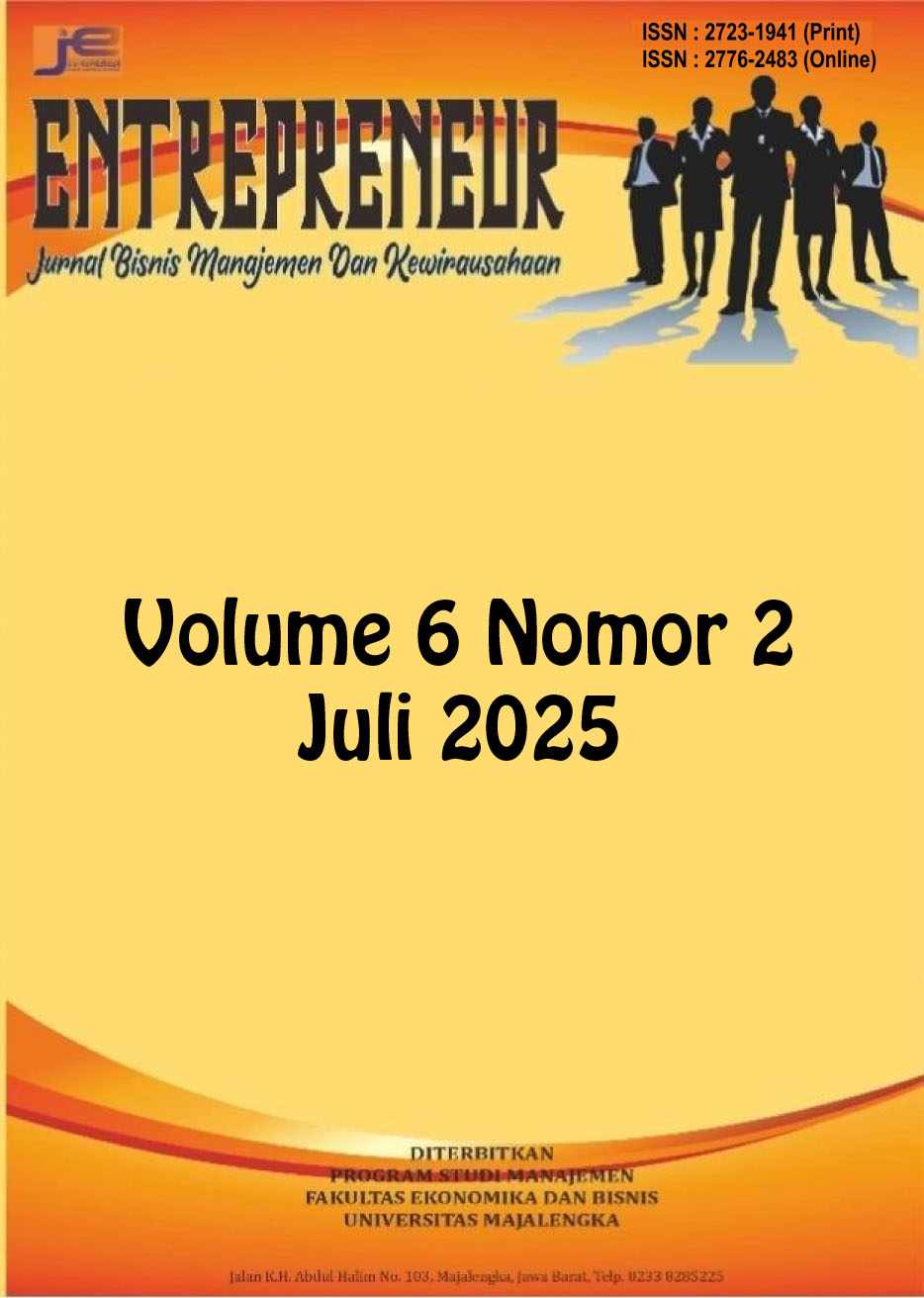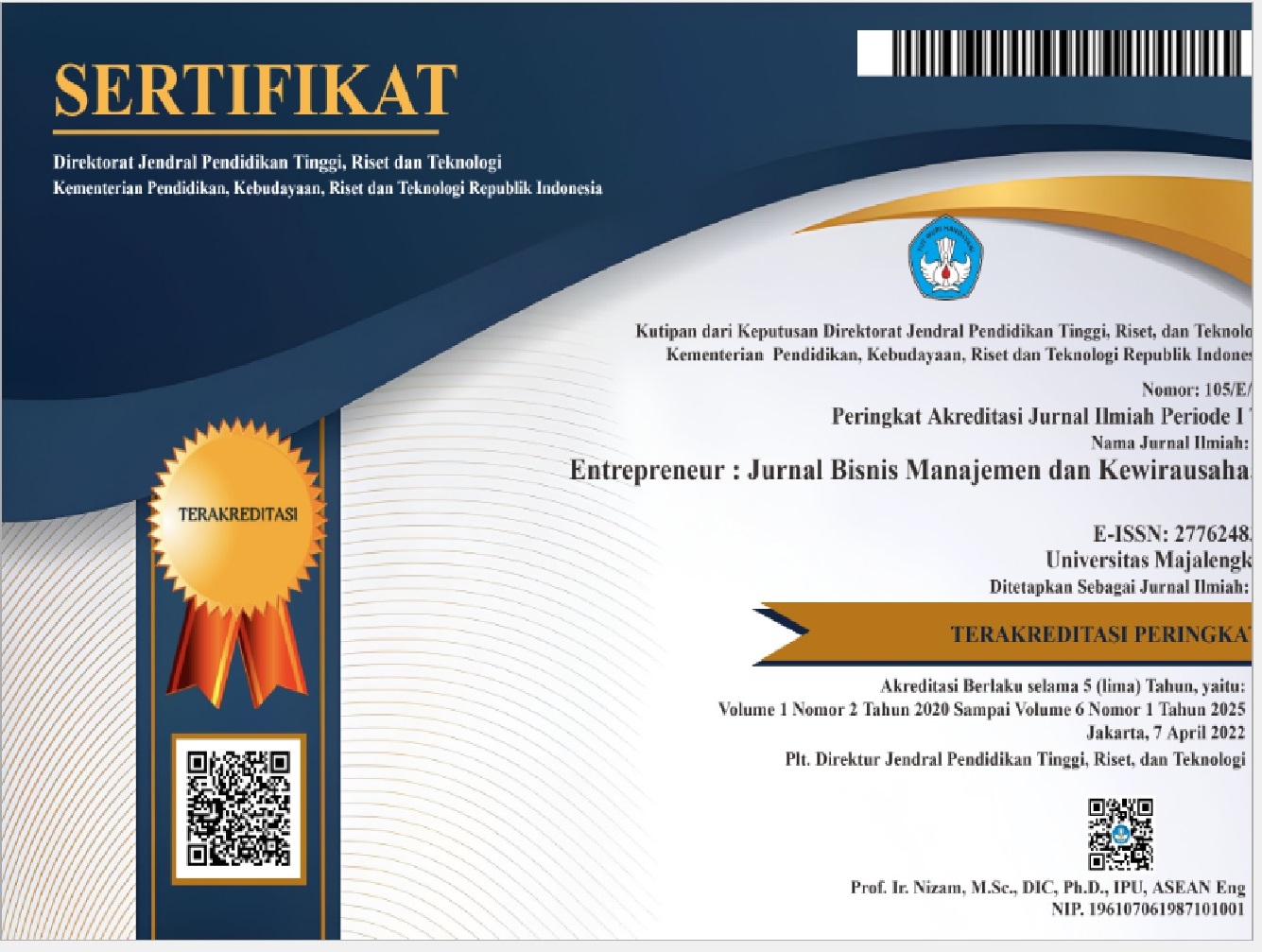Analisis Partisipasi Masyarakat Dan Peran Perangkat Desa Terhadap Pembangunan Desa Labuhan Kertasari, Kecamatan Taliwang, Kabupaten Sumbawa Barat
DOI:
https://doi.org/10.31949/entrepreneur.v6i2.13935Abstract
This study examines the role of community participation and village officials in the development of Labuhan Kertasari Village, Taliwang District, West Sumbawa Regency. Sustainable and inclusive village development requires synergy between active community participation and the effective role of village officials. This study aims to analyze the influence of community participation and the role of village officials on village development. A quantitative method was used in this research. The population in this study consists of all residents of Labuhan Kertasari Village, Taliwang District, West Sumbawa Regency, totaling 2,326 people. Primary data were collected through questionnaires from 100 respondents. Data analysis was conducted using Structural Equation Modeling-Partial Least Squares (SEM-PLS). The results show that both community participation and the role of village officials have a positive and significant effect on village development. Active community involvement in every stage of development, from planning to supervision, is crucial to ensure that development aligns with local needs. Competent and transparent village officials in managing village resources are also key factors in the effectiveness of development. Community participation and the role of village officials are essential factors in sustainable and inclusive village development. The implications of this study highlight the need to improve the capacity of both the community and village officials, ensure transparency in village fund management, and foster good collaboration among all relevant stakeholders to achieve more effective and equitable village development.
Keywords:
Community Participation, Role of Village Officials, Village DevelopmentDownloads
References
Arnstein, S. R. (2019). A Ladder of Citizen Participation. Journal of the American Planning Association, 85(1), 24-34.
BPS. (2022). Statistik Kemiskinan dan Ketimpangan di Indonesia. Jakarta: BPS.
Chambers, R. (2020). Rural Development: Putting the Last First. Routledge.
Hair, J. F., Hult, G. T. M., Ringle, C. M., & Sarstedt, M. (2021). A primer on partial least squares structural equation modeling (PLS-SEM) (3rd ed.). Sage Publications.
Hidayat, A., & Yani, S. Z. F. (2022). Peran Administrasi Pembangunan Desa. Jurnal Inovasi Penelitian, 3(7), 7091-7100.
Jaa, E., Sulistyo, S., & Setiyowati, S. W. (2019). Pengaruh Transparansi, Akuntabilitas, Dan Partisipasi Masyarakat Pada Pengelolaan Alokasi Dana Desa (Add) Terhadap Pembangunan Desa. Jurnal Riset Mahasiswa Akuntansi, 7(1).
KLHK. (2021). Laporan Status Lingkungan Hidup Indonesia 2021. Jakarta: KLHK.
Mansuri, G., & Rao, V. (2022). Localizing Development: Does Participation Work?. World Bank Publications.
Mulyanto, (2013). Indikator Dan Karakteristik Pembangunan Desa Sebagai Basis
Nasir, M. (2019). Desa Mandiri: Strategi Pembangunan Berkelanjutan. Bandung: Alfabeta.
Romi, AS, M. (2019). Pengaruh Partisipasi Masyarakat Terhadap Pembangunan Desa. Jurnal Ilmu Sosial dan Ilmu Politik (JISIP), 8(2), 26-33.
Sari, R. (2021). Partisipasi Masyarakat dalam Pembangunan Desa. Medan: USU Press.
Supriyanto, A. (2020). Manajemen Pembangunan Desa: Teori dan Aplikasi. Surabaya: Airlangga University Press.
Usman, N. A., & Yaya, R. (2023). Pengaruh Transparansi, Akuntabilitas, Partisipasi Masyarakat, dan Peran Perangkat Desa terhadap Pembangunan Desa. Jurnal Manajemen Dinamis, 1(2), 100-108.
Wibowo, A., & Nugroho, B. (2020). Kapasitas Perangkat Desa dalam Mengelola Program Pembangunan: Studi di Jawa Tengah. Jurnal Administrasi Publik, 18(2), 112-125.

Published
How to Cite
Issue
Section
License
Copyright (c) 2025 Nurifa Irma Suryani, Sri Rahayu

This work is licensed under a Creative Commons Attribution-ShareAlike 4.0 International License.
COPYRIGHT NOTICE
An author who publishes in the Entrepreneur: Jurnal Bisnis Manajemen dan Kewirausahaan agrees to the following terms:
1. Author retains the copyright and grants the journal the right of first publication of the work simultaneously licensed under the Creative Commons Attribution-ShareAlike 4.0 License that allows others to share the work with an acknowledgment of the work's authorship and initial publication in this journal
2. The author is able to enter into separate, additional contractual arrangements for the non-exclusive distribution of the journal's published version of the work (e.g., post it to an institutional repository or publish it in a book) with the acknowledgment of its initial publication in this journal.
3. The author is permitted and encouraged to post his/her work online (e.g., in institutional repositories or on their website) prior to and during the submission process, as it can lead to productive exchanges, as well as earlier and greater citation of the published work







